
May is a seminal month in Karachi, an intermediary that hints of the pleasures of a South Asian summer. The searing April heat is omnipresent but in late afternoons you can hear the cuckoo’s song that makes it palatable. Since youth, I have heard the melodious sound and to this day it brings back memories of final exams, the never ending wait for summer vacations, gola ganda (ice cones) and all the other things that made summer the most important season for a child.
It truly is the sound of Karachi’s summer, a redoubtable counterpart to the robin’s warble that heralds spring or the cries of the south flying birds that welcome winter.
[caption id="" align="alignnone" width="540" caption="Photo: File"] [/caption]
Karachi’s summer weather is deliciously fickle, a courtesan whose coquetry and harsh indifference distracts one to distraction but come sundown she opens her charm first with a zephyr of cool sea breeze and then the loving embrace of the night’s quietude.
Sultry days give way to ochre, silky dusks which melt into indigo nights and the moon never looks as kindly as it does then.
Summers in those bygone days meant mangoes which always tasted better when unripe and stolen from a neighbour’s house. Of course, the green unripe fruit would, through alchemy, transform into the king of fruits to be gobbled at breakfast with piping hot parathas, eaten for lunch with crumbly baisan ki roti and at dinner as dessert with fresh cream.
There would be other homemade mango delights such as ice cream, shakes, squash, pickle, and the Amrohvi filfora- a scrumptious concoction of mango pulp, onions, fresh mint, and chillies which is eaten for lunch with buttered bread. There would be mango parties with buckets of iced mangoes and ample utensils and appetite to go around. We would be as bold with our consumption as our tummies would allow.
[caption id="" align="alignnone" width="540" caption="Photo: AFP"]
[/caption]
Karachi’s summer weather is deliciously fickle, a courtesan whose coquetry and harsh indifference distracts one to distraction but come sundown she opens her charm first with a zephyr of cool sea breeze and then the loving embrace of the night’s quietude.
Sultry days give way to ochre, silky dusks which melt into indigo nights and the moon never looks as kindly as it does then.
Summers in those bygone days meant mangoes which always tasted better when unripe and stolen from a neighbour’s house. Of course, the green unripe fruit would, through alchemy, transform into the king of fruits to be gobbled at breakfast with piping hot parathas, eaten for lunch with crumbly baisan ki roti and at dinner as dessert with fresh cream.
There would be other homemade mango delights such as ice cream, shakes, squash, pickle, and the Amrohvi filfora- a scrumptious concoction of mango pulp, onions, fresh mint, and chillies which is eaten for lunch with buttered bread. There would be mango parties with buckets of iced mangoes and ample utensils and appetite to go around. We would be as bold with our consumption as our tummies would allow.
[caption id="" align="alignnone" width="540" caption="Photo: AFP"] [/caption]
Mangoes were a recurring refrain but no less exciting were the summer sports. The dive in the icy pool marked the beginning of vacations and no week would be complete without a pool foray. Nights would be put to good use with cricket. I played out several Imran Khan exploits in my head only to discover a woeful lack of talent.
[caption id="" align="alignnone" width="540" caption="Photo: Reuters"]
[/caption]
Mangoes were a recurring refrain but no less exciting were the summer sports. The dive in the icy pool marked the beginning of vacations and no week would be complete without a pool foray. Nights would be put to good use with cricket. I played out several Imran Khan exploits in my head only to discover a woeful lack of talent.
[caption id="" align="alignnone" width="540" caption="Photo: Reuters"] [/caption]
Nonetheless, the dawn halwa puri breakfast would more than make up for any defeats and soon I was making plans for the next match. If it wasn't outdoor sports then it were indoor games. Carom, scrabble, ludo, and chess were fixtures and helped through the lazy afternoons. Monopoly notes would be hoarded in sweaty palms until they fell apart and card sessions would last hours until the inevitable fights over barely concealed cheating or the yelling from elders to quiet down.
Summer meant visiting cousins and spending the night at houses of tired but welcoming relatives and even random acquaintances for no reason. It meant having access to summer delights - video games for instance. It was the season for books with Enid Blyton, Roald Dahl, and Dickens - firm favourites. Comic books would be bought by the dozen and guarded and exchanged with all the earnestness of a Wall Street transaction. Comics would be best enjoyed in solitude or possibly around grandparents since they never asked silly questions about powers and costumes.
Load shedding was ubiquitous but generators were still a luxury and the hum of the machines would be replaced by the cries of kids on the roads playing games of baraf pani and tag while the elders talked in the candle light or under the glow of emergency lights. Toddlers would swing in crude but effective dupatta hammocks and fall asleep in the serenity whilst listening to a grandmother’s lullaby.
[caption id="" align="alignnone" width="540" caption="Photo: AFP"]
[/caption]
Nonetheless, the dawn halwa puri breakfast would more than make up for any defeats and soon I was making plans for the next match. If it wasn't outdoor sports then it were indoor games. Carom, scrabble, ludo, and chess were fixtures and helped through the lazy afternoons. Monopoly notes would be hoarded in sweaty palms until they fell apart and card sessions would last hours until the inevitable fights over barely concealed cheating or the yelling from elders to quiet down.
Summer meant visiting cousins and spending the night at houses of tired but welcoming relatives and even random acquaintances for no reason. It meant having access to summer delights - video games for instance. It was the season for books with Enid Blyton, Roald Dahl, and Dickens - firm favourites. Comic books would be bought by the dozen and guarded and exchanged with all the earnestness of a Wall Street transaction. Comics would be best enjoyed in solitude or possibly around grandparents since they never asked silly questions about powers and costumes.
Load shedding was ubiquitous but generators were still a luxury and the hum of the machines would be replaced by the cries of kids on the roads playing games of baraf pani and tag while the elders talked in the candle light or under the glow of emergency lights. Toddlers would swing in crude but effective dupatta hammocks and fall asleep in the serenity whilst listening to a grandmother’s lullaby.
[caption id="" align="alignnone" width="540" caption="Photo: AFP"]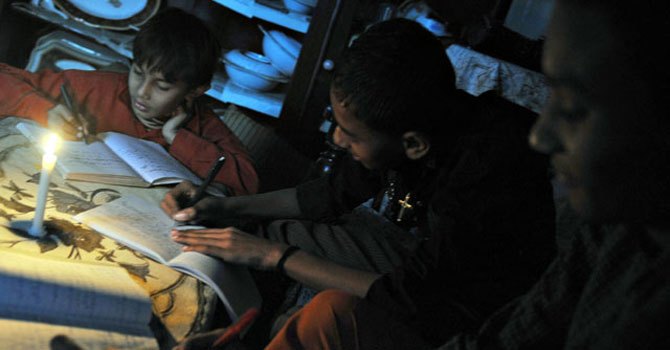 [/caption]
The doggone days would pile up, the heat would increase and just when you thought that Dante’s inferno is coming to life, the heavens would open and down out everything in a deluge of warm summer rain. The lashing monsoon would wash away the physical and mental grime, leaving souls weightless and lead to splashing in puddles, water games and much revelry.
[caption id="" align="alignnone" width="540" caption="Photo: AFP"]
[/caption]
The doggone days would pile up, the heat would increase and just when you thought that Dante’s inferno is coming to life, the heavens would open and down out everything in a deluge of warm summer rain. The lashing monsoon would wash away the physical and mental grime, leaving souls weightless and lead to splashing in puddles, water games and much revelry.
[caption id="" align="alignnone" width="540" caption="Photo: AFP"] [/caption]
The event to mark it all would be the annual beach picnic. Uncles would plan like war generals; mothers would cook to feed entire battalions and the trumpet call would be planned for very early morning. Year after year the deadline to depart would be set and missed with equal regularity.
The waves would beckon like sirens and the entire day would be spent getting brown and blissfully wet. We would return late in the evening, more seal than human, temporarily sated and utterly happy.
[caption id="" align="alignnone" width="540" caption="Photo: AFP"]
[/caption]
The event to mark it all would be the annual beach picnic. Uncles would plan like war generals; mothers would cook to feed entire battalions and the trumpet call would be planned for very early morning. Year after year the deadline to depart would be set and missed with equal regularity.
The waves would beckon like sirens and the entire day would be spent getting brown and blissfully wet. We would return late in the evening, more seal than human, temporarily sated and utterly happy.
[caption id="" align="alignnone" width="540" caption="Photo: AFP"] [/caption]
Come August you could hear a dirge - the millions of children lamenting summer’s end.
School shopping would start and we would start the academic year finding solace in the knowledge that it may seem like an eternity, but we will eventually be welcoming another Karachi summer!
Follow Sibtain on Twitter @sibtain_n
[/caption]
Come August you could hear a dirge - the millions of children lamenting summer’s end.
School shopping would start and we would start the academic year finding solace in the knowledge that it may seem like an eternity, but we will eventually be welcoming another Karachi summer!
Follow Sibtain on Twitter @sibtain_n

 Federer pictured second from the right is joined by former champions Bjorn Borg (left), Pete Sampras (center) and to the far right Rod Laver. PHOTO: AFP[/caption]
On July 6th, 2008 the tennis world was in the midst of another revolution. Federer was about to face the first man who beat him in a Grand Slam final. If Federer won Wimbledon 2008, he would become the first man in this Open era to win six straight championships.
Federer pictured second from the right is joined by former champions Bjorn Borg (left), Pete Sampras (center) and to the far right Rod Laver. PHOTO: AFP[/caption]
On July 6th, 2008 the tennis world was in the midst of another revolution. Federer was about to face the first man who beat him in a Grand Slam final. If Federer won Wimbledon 2008, he would become the first man in this Open era to win six straight championships. 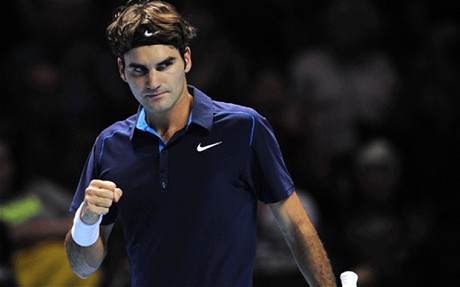 PHOTO: AFP[/caption]
Then Nadal went on to beat Djokovic at the Queen’s Club, and then iconic five time Wimbledon Champion Bjorn Borg dubbed Nadal as the favorite for this year’s Championship.
[caption id="" align="alignnone" width="427"]
PHOTO: AFP[/caption]
Then Nadal went on to beat Djokovic at the Queen’s Club, and then iconic five time Wimbledon Champion Bjorn Borg dubbed Nadal as the favorite for this year’s Championship.
[caption id="" align="alignnone" width="427"] The new champion sinks to the ground in ecstasy with a long emotional release. PHOTO: REUTERS[/caption]
There was a
The new champion sinks to the ground in ecstasy with a long emotional release. PHOTO: REUTERS[/caption]
There was a  Andy Murray, in 2013, and Fred Perry, in 1934.
Andy Murray, in 2013, and Fred Perry, in 1934. Federer consoles Murray after his Wimbledon loss in 2012.
Federer consoles Murray after his Wimbledon loss in 2012. Andy Murray poses with his gold medal at the end of the men's singles tennis tournament of the London 2012 Olympic Games. Photo: AFP[/caption]
Now he stands apart from the also-rans and has his name inscribed in gold letters in the honors roll at Wimbledon.
The joy of the nation is a sight to be seen and they now have a genuine, dyed in the wool champion. Honors will flow in, a knighthood (he already has an OBE), endorsements, perhaps even a road or two named after him. Toasts will be raised to him and we may see a scowling Andy statue at Murray Hill. Elton John will write a ballad and for a few days the English will forget about the Beckhams and the ovarian lottery winner due in a few months. But nothing will capture the moment of his win in the world’s premier tournament, the thundering applause and the non-stop shouts of “
Andy Murray poses with his gold medal at the end of the men's singles tennis tournament of the London 2012 Olympic Games. Photo: AFP[/caption]
Now he stands apart from the also-rans and has his name inscribed in gold letters in the honors roll at Wimbledon.
The joy of the nation is a sight to be seen and they now have a genuine, dyed in the wool champion. Honors will flow in, a knighthood (he already has an OBE), endorsements, perhaps even a road or two named after him. Toasts will be raised to him and we may see a scowling Andy statue at Murray Hill. Elton John will write a ballad and for a few days the English will forget about the Beckhams and the ovarian lottery winner due in a few months. But nothing will capture the moment of his win in the world’s premier tournament, the thundering applause and the non-stop shouts of “

 The Family together, notice the ubiquitous Ambassador car in the back. Photo: Sibtain Naqvi[/caption]
I have been there a few times. My friends always ask me why I visit so often. Why not Malaysia or Thailand they question. It is not easy to enunciate my reasons; one only has to look around at the people around me to understand why. It’s the sense of belonging and the commonalities that bind me to the town of my forefathers in Uttar Pradesh. It’s the call of my ancestors’ dilapidated havelis, to rediscover my roots and much more.
[caption id="" align="alignnone" width="400"]
The Family together, notice the ubiquitous Ambassador car in the back. Photo: Sibtain Naqvi[/caption]
I have been there a few times. My friends always ask me why I visit so often. Why not Malaysia or Thailand they question. It is not easy to enunciate my reasons; one only has to look around at the people around me to understand why. It’s the sense of belonging and the commonalities that bind me to the town of my forefathers in Uttar Pradesh. It’s the call of my ancestors’ dilapidated havelis, to rediscover my roots and much more.
[caption id="" align="alignnone" width="400"] Mango orchards. Photo: Sibtain Naqvi[/caption]
The journey began some twenty years back. There was a family wedding with guests arriving from India. I was breathless with excitement. The flight was delayed and I fell asleep. Abba woke me telling me they had arrived and I rushed to see them.
[caption id="" align="alignnone" width="600"]
Mango orchards. Photo: Sibtain Naqvi[/caption]
The journey began some twenty years back. There was a family wedding with guests arriving from India. I was breathless with excitement. The flight was delayed and I fell asleep. Abba woke me telling me they had arrived and I rushed to see them.
[caption id="" align="alignnone" width="600"]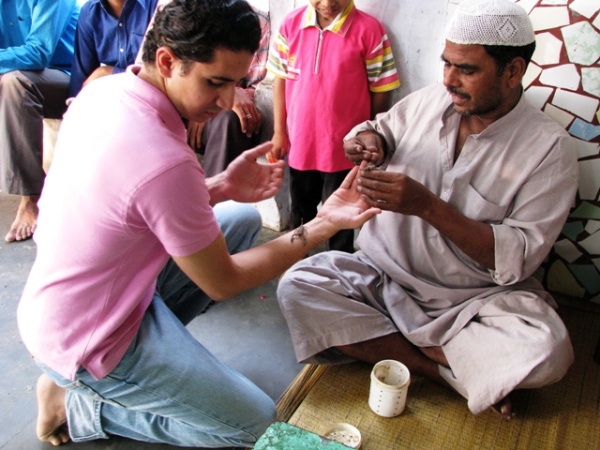 Holding a scorpion in the shirne of Hazrat Shahwilayat patron saint of Amroha. The scorpions are sacred and don't sting. Photo: Sibtain Naqvi[/caption]
As soon as I came into the room, previously unseen uncles, aunts and cousins swept me in their arms. I realised then that these are my people, people who are far away from me, but who love me like their own. I have never met them nor will I be meeting them often but they will be a part of my days, my conversations, my future plans and my family occasions.
[caption id="" align="alignnone" width="400"]
Holding a scorpion in the shirne of Hazrat Shahwilayat patron saint of Amroha. The scorpions are sacred and don't sting. Photo: Sibtain Naqvi[/caption]
As soon as I came into the room, previously unseen uncles, aunts and cousins swept me in their arms. I realised then that these are my people, people who are far away from me, but who love me like their own. I have never met them nor will I be meeting them often but they will be a part of my days, my conversations, my future plans and my family occasions.
[caption id="" align="alignnone" width="400"] No trip was complete without a visit to the Qutb Minar. Photo: Sibtain Naqvi[/caption]
8:00am, December 7, 2012:
The bus is crossing the
No trip was complete without a visit to the Qutb Minar. Photo: Sibtain Naqvi[/caption]
8:00am, December 7, 2012:
The bus is crossing the 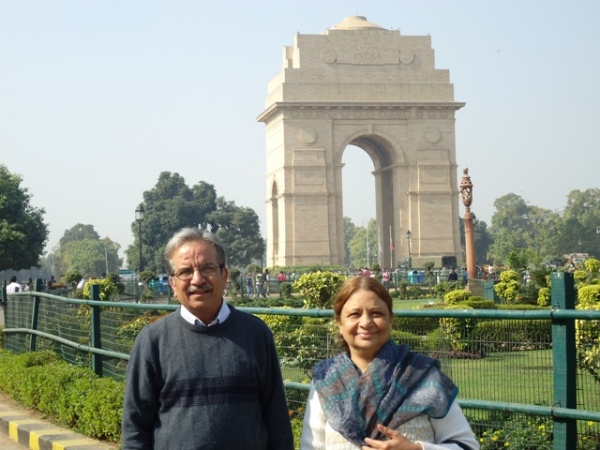 My parents in front of India Gate Delhi. Photo: Sibtain Naqvi[/caption]
Yet the border with its menacing walls and capricious gates is there. What the partition was meant to be or what could have been had it not happened is a futile debate. Oceans of ink could be bled on the subject but the fact is that there is no way of undoing what was done. Even so, four wars, countless skirmishes, jingoistic politicians and hard liners on both sides cannot change the fact that for thousands of years this was one land with one people.
[caption id="" align="alignnone" width="675"]
My parents in front of India Gate Delhi. Photo: Sibtain Naqvi[/caption]
Yet the border with its menacing walls and capricious gates is there. What the partition was meant to be or what could have been had it not happened is a futile debate. Oceans of ink could be bled on the subject but the fact is that there is no way of undoing what was done. Even so, four wars, countless skirmishes, jingoistic politicians and hard liners on both sides cannot change the fact that for thousands of years this was one land with one people.
[caption id="" align="alignnone" width="675"] With my parents and sister in Delhi's Lal Qila. Photo: Sibtain Naqvi[/caption]
For eight centuries the Muslims lived here absorbing culture and adding their own blend to the tapestry called Hindustan - Hindustan, named by the Arab traders, meaning land of beauty - Hindustan, the golden bird of riches for which no less a personage than Iqbal wrote these immortal words:
With my parents and sister in Delhi's Lal Qila. Photo: Sibtain Naqvi[/caption]
For eight centuries the Muslims lived here absorbing culture and adding their own blend to the tapestry called Hindustan - Hindustan, named by the Arab traders, meaning land of beauty - Hindustan, the golden bird of riches for which no less a personage than Iqbal wrote these immortal words:
 Blessing a groom the old way with ubtan and loads of love. Photo: Sibtain Naqvi[/caption]
England and France, Russia and America, Germany and France, China and Japan and so many more were all at one point bitter enemies but now exist together at best in perfect harmony and at worst with at least modicum of stable relationship.
[caption id="" align="alignnone" width="640"]
Blessing a groom the old way with ubtan and loads of love. Photo: Sibtain Naqvi[/caption]
England and France, Russia and America, Germany and France, China and Japan and so many more were all at one point bitter enemies but now exist together at best in perfect harmony and at worst with at least modicum of stable relationship.
[caption id="" align="alignnone" width="640"] As unbelievable as this may sound but a familiar sight in Delhi. Photo: Sibtain Naqvi[/caption]
Sadly, India and Pakistan don’t see eye to eye in spite of a shared language, architecture, food, music, entertainment, ceremonies, traditions, clothing and norms.
[caption id="" align="alignnone" width="600"]
As unbelievable as this may sound but a familiar sight in Delhi. Photo: Sibtain Naqvi[/caption]
Sadly, India and Pakistan don’t see eye to eye in spite of a shared language, architecture, food, music, entertainment, ceremonies, traditions, clothing and norms.
[caption id="" align="alignnone" width="600"] Basking in the winter sun of Amroha UP and company of Indian relatives. Photo: Sibtain Naqvi[/caption]
8:00pm, December 7, 2012:
I am 40km from Delhi and the roads now look familiar. The excitement of travellers is detectable and they are peering out of windows. A middle-aged gentleman in front of me is going after 27 years and even though he is grinning I can make out that his cheeks are wet. He tells me of rejected visas and numerous visits to the Indian consulate. All his relatives are coming to receive him. His mother, a sister and two brothers will not be among them. They passed away in the midst of a long gap of his visits a few years back.
[caption id="" align="alignnone" width="337"]
Basking in the winter sun of Amroha UP and company of Indian relatives. Photo: Sibtain Naqvi[/caption]
8:00pm, December 7, 2012:
I am 40km from Delhi and the roads now look familiar. The excitement of travellers is detectable and they are peering out of windows. A middle-aged gentleman in front of me is going after 27 years and even though he is grinning I can make out that his cheeks are wet. He tells me of rejected visas and numerous visits to the Indian consulate. All his relatives are coming to receive him. His mother, a sister and two brothers will not be among them. They passed away in the midst of a long gap of his visits a few years back.
[caption id="" align="alignnone" width="337"] My father taking part in a traditional procession. Photo: Sibtain Naqvi[/caption]
There is more binding us than keeping us apart. M Rafi, Dilip Kumar and Shahrukh Khan are loved on both sides. Pakistanis are just as fond of Kishore Kumar and Jagjit Singh as anyone. Nazia Hassan recorded her biggest hit in India and sang for several movies. Nusrat Fateh Ali Khan, Imran Khan and Shahid Afridi were swamped with fans on both sides of the border. Sadequain painted in India, Kaifi Azmi recited poetry here.
[caption id="" align="alignnone" width="600"]
My father taking part in a traditional procession. Photo: Sibtain Naqvi[/caption]
There is more binding us than keeping us apart. M Rafi, Dilip Kumar and Shahrukh Khan are loved on both sides. Pakistanis are just as fond of Kishore Kumar and Jagjit Singh as anyone. Nazia Hassan recorded her biggest hit in India and sang for several movies. Nusrat Fateh Ali Khan, Imran Khan and Shahid Afridi were swamped with fans on both sides of the border. Sadequain painted in India, Kaifi Azmi recited poetry here.
[caption id="" align="alignnone" width="600"] Artist Sadequain reading a marsiya in Amroha UP- 1984. Photo: Sibtain Naqvi[/caption]
Pakistanis, travel to Hyderabad and Bangalore for medical reasons and come back with glowing tales of hospitality. When the Indian cricket team visited Pakistan in 2003 the restaurant owners refused to charge them. In Pakistan saying you are a visiting Indian means discounts at shops and stories of common backgrounds. Sadly, ulterior motives and weak resolve by the powers that be stall peace progress at every turn.
[caption id="" align="alignnone" width="337"]
Artist Sadequain reading a marsiya in Amroha UP- 1984. Photo: Sibtain Naqvi[/caption]
Pakistanis, travel to Hyderabad and Bangalore for medical reasons and come back with glowing tales of hospitality. When the Indian cricket team visited Pakistan in 2003 the restaurant owners refused to charge them. In Pakistan saying you are a visiting Indian means discounts at shops and stories of common backgrounds. Sadly, ulterior motives and weak resolve by the powers that be stall peace progress at every turn.
[caption id="" align="alignnone" width="337"] Birds in my ancestors' home; no border bars their way. Photo: Sibtain Naqvi[/caption]
8:00am, January 2, 2013:
I am almost at Pipri, two hours from
Birds in my ancestors' home; no border bars their way. Photo: Sibtain Naqvi[/caption]
8:00am, January 2, 2013:
I am almost at Pipri, two hours from  Another visit another goodbye My grandmother is 2nd from left with my sister in her lap. Photo: Sibtain Naqvi[/caption]
When will Pakistan and India relations normalise? When will I simply walk across Wagah and travel across the length and breadth of India?
[caption id="" align="alignnone" width="600"]
Another visit another goodbye My grandmother is 2nd from left with my sister in her lap. Photo: Sibtain Naqvi[/caption]
When will Pakistan and India relations normalise? When will I simply walk across Wagah and travel across the length and breadth of India?
[caption id="" align="alignnone" width="600"]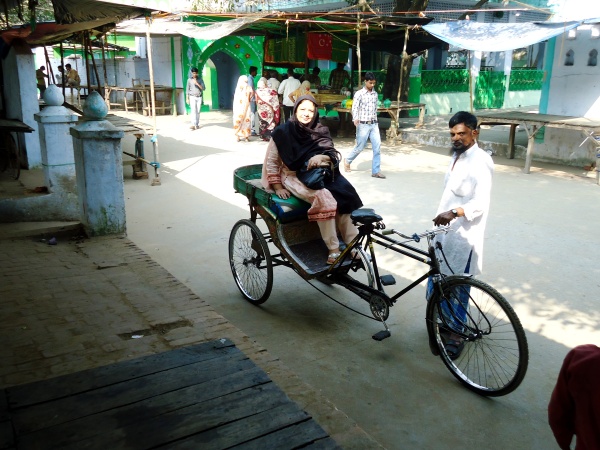 Cycle rickshaws economical and fun. Photo: Sibtain Naqvi[/caption]
I don’t know but I have hope that eventually the common bonds of love, culture and mutual interests will win out and the dark stories of rejected visas and
Cycle rickshaws economical and fun. Photo: Sibtain Naqvi[/caption]
I don’t know but I have hope that eventually the common bonds of love, culture and mutual interests will win out and the dark stories of rejected visas and  My first visit in 1982 I am the first infant from right and wearing a white sweater. Photo: Sibtain Naqvi[/caption]
My first visit in 1982 I am the first infant from right and wearing a white sweater. Photo: Sibtain Naqvi[/caption]
 Pakistani Cricketer Hanif Mohammad. PHOTO: Cricinfo[/caption]
Vanguard of the willow-wielders
Statistics bewilder and confound. AH Kardar’s “find of the decade”, Javed had a century at debut, the youngest player at the time to do so. He soon became the youngest batsman to score a double, a record held by George Headley for 47 years. Although not from the classical mold, he had all shots in the book and then some. His aggregate of 8,832 Test runs is a Pakistani record. His 23 centuries and 43 fifties were national records, until broken by
Pakistani Cricketer Hanif Mohammad. PHOTO: Cricinfo[/caption]
Vanguard of the willow-wielders
Statistics bewilder and confound. AH Kardar’s “find of the decade”, Javed had a century at debut, the youngest player at the time to do so. He soon became the youngest batsman to score a double, a record held by George Headley for 47 years. Although not from the classical mold, he had all shots in the book and then some. His aggregate of 8,832 Test runs is a Pakistani record. His 23 centuries and 43 fifties were national records, until broken by  Dennis Lillee and Javed Miandad clash. PHOTO: Cricinfo[/caption]
Man of crisis
But if Javed was a master class in snatching victory from the jaws, nay the very innards of crushing defeat, Hanif was a maestro of the rear guard action that would make King Leonidas proud. One of the most exciting things in Tests is a team fighting to save a test match. Think
Dennis Lillee and Javed Miandad clash. PHOTO: Cricinfo[/caption]
Man of crisis
But if Javed was a master class in snatching victory from the jaws, nay the very innards of crushing defeat, Hanif was a maestro of the rear guard action that would make King Leonidas proud. One of the most exciting things in Tests is a team fighting to save a test match. Think 





 Khaleesi epic moment leading the unsullied army. Source: IMDb[/caption]
My booming cry was, of course, a reference to that wildly successful HBO TV show,
Khaleesi epic moment leading the unsullied army. Source: IMDb[/caption]
My booming cry was, of course, a reference to that wildly successful HBO TV show,  Series of novels by George R R Martin. Photo: Reuters[/caption]
The show finished its third season this summer and has received both critical and commercial acclaim.
Is it the greatest TV show of all time?
This scribe can agree but there are naysayers aplenty. In just the comedy section many swear by Simpsons or Friends while the older and truly ancient enthuse about Seinfeld and Happy Days. In the drama genre Sopranos’ fans give stiletto glares if you mention GOT being ‘GOAT’ (yes, Roger Federer has another challenger) while my father’s generation would mention Kojak and give GOT the same withering look that the Dowager Countess of Grantham from Downtown Abbey would give to the prospect of watching an
Series of novels by George R R Martin. Photo: Reuters[/caption]
The show finished its third season this summer and has received both critical and commercial acclaim.
Is it the greatest TV show of all time?
This scribe can agree but there are naysayers aplenty. In just the comedy section many swear by Simpsons or Friends while the older and truly ancient enthuse about Seinfeld and Happy Days. In the drama genre Sopranos’ fans give stiletto glares if you mention GOT being ‘GOAT’ (yes, Roger Federer has another challenger) while my father’s generation would mention Kojak and give GOT the same withering look that the Dowager Countess of Grantham from Downtown Abbey would give to the prospect of watching an 
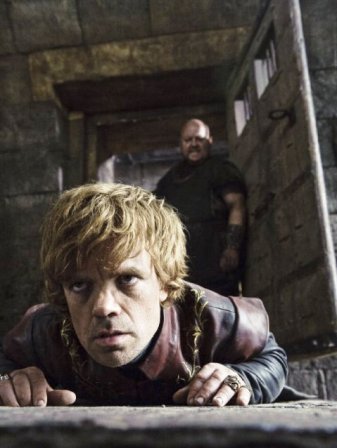 Tyrion Lannister. Source: IMDb[/caption]
Either that or I end up being branded a moron and live with the shame of being daft but that is a risk we mavericks have to take. But those who mock and malign, beware…
Tyrion Lannister. Source: IMDb[/caption]
Either that or I end up being branded a moron and live with the shame of being daft but that is a risk we mavericks have to take. But those who mock and malign, beware…

 Photo: Sibtain Naqvi[/caption]
It is serious eating here, with no fancy presentations or garnishes, just honest, good food that lures the eater into a bacchanal of gluttony. My first experience was no light hearted affair but a complete immersion in the victuals on offer.
While perusing the various places, even the most casual observer will notice the predominance of restaurants that hark back to the city of Delhi. You can hear the echoes of
Photo: Sibtain Naqvi[/caption]
It is serious eating here, with no fancy presentations or garnishes, just honest, good food that lures the eater into a bacchanal of gluttony. My first experience was no light hearted affair but a complete immersion in the victuals on offer.
While perusing the various places, even the most casual observer will notice the predominance of restaurants that hark back to the city of Delhi. You can hear the echoes of  Photo: Sibtain Naqvi[/caption]
Waheed’s Nihari is probably the best known place and one bite of the hot, gelatinous concoction will make it clear why it is so. Perhaps the cleanliness of the floor might deter some, but do not be alarmed since the plates are incontestably clean. The ambience resonates with that of the fictional
Photo: Sibtain Naqvi[/caption]
Waheed’s Nihari is probably the best known place and one bite of the hot, gelatinous concoction will make it clear why it is so. Perhaps the cleanliness of the floor might deter some, but do not be alarmed since the plates are incontestably clean. The ambience resonates with that of the fictional  Photo: Sibtain Naqvi[/caption]
If
Photo: Sibtain Naqvi[/caption]
If  Photo: Sibtain Naqvi[/caption]
Burns Road caters to a variety of tastes, so capricious epicures need not worry. If snacks are what you are looking for then look no further than Fresco Sweets, famous for its
Photo: Sibtain Naqvi[/caption]
Burns Road caters to a variety of tastes, so capricious epicures need not worry. If snacks are what you are looking for then look no further than Fresco Sweets, famous for its  Photo: Sibtain Naqvi[/caption]
After sampling Karhai, Nihari, Sajji or
Photo: Sibtain Naqvi[/caption]
After sampling Karhai, Nihari, Sajji or  Photo: Sibtain Naqvi[/caption]
In summer, it is a godsend and banishes the heat demons just as effectively.
Photo: Sibtain Naqvi[/caption]
In summer, it is a godsend and banishes the heat demons just as effectively. 

 March 9, 1996
Just over four years later, the two teams met again in a World Cup match in the 1996 Quarter-final. It was a knock out and the stakes could not have been higher.
Pakistan had played well in the group stage with the only loss against hot favourites, South Africa. The M Chinnaswamy Stadium, in Bangalore, was packed to the rafters with 40,000 screaming fans. India won the toss and keeping in mind Pakistan’s poor record in chasing batted first.
Not for the first time against Pakistan, Navjot Sidhu played an exceptional innings and fell just seven shy from an outstanding century against what many described as the best bowling attack in the world. Captain
March 9, 1996
Just over four years later, the two teams met again in a World Cup match in the 1996 Quarter-final. It was a knock out and the stakes could not have been higher.
Pakistan had played well in the group stage with the only loss against hot favourites, South Africa. The M Chinnaswamy Stadium, in Bangalore, was packed to the rafters with 40,000 screaming fans. India won the toss and keeping in mind Pakistan’s poor record in chasing batted first.
Not for the first time against Pakistan, Navjot Sidhu played an exceptional innings and fell just seven shy from an outstanding century against what many described as the best bowling attack in the world. Captain 
 But why stop there? The worthy thinkers who floated this ‘brilliant’ idea should also consider all classes of female travellers. What about the females who take rickshaws?
Are they not in danger as well? I suggest the government should launch a line of female-only rickshaws or ‘Pinkies’ to give it a feminine twang. Imagine a troop of pink rickshaws, their silencers tuned to putter along with ‘Ay Hai Ay Hai’ and not ‘ruk tuk ruk tuk’.
Or instead of lines like
But why stop there? The worthy thinkers who floated this ‘brilliant’ idea should also consider all classes of female travellers. What about the females who take rickshaws?
Are they not in danger as well? I suggest the government should launch a line of female-only rickshaws or ‘Pinkies’ to give it a feminine twang. Imagine a troop of pink rickshaws, their silencers tuned to putter along with ‘Ay Hai Ay Hai’ and not ‘ruk tuk ruk tuk’.
Or instead of lines like 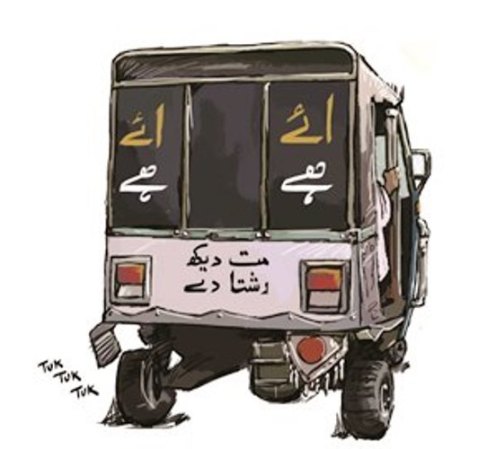 Design: Jamal Khurshid[/caption]
Rickshaw drivers normally put a
Design: Jamal Khurshid[/caption]
Rickshaw drivers normally put a  Design: Blogs Desk[/caption]
However, certain people might object to the curvy shape, streamlined sides and pleasant pink hues of an ‘Extra Virgin’ airplane. So, the best thing would be to move towards a zeppelin or an air craft with an amorphous shape so as to avoid exciting these individuals. If that does not work we can always drape a black billowy cloth over it with a slit for the pilot’s view to keep the planes modest and traditional. That will really safeguard the female travellers from the lascivious menfolk on the ground below.
And then, once travel is made secure for females, our worthy government can rest easy and get on to the issues of
Design: Blogs Desk[/caption]
However, certain people might object to the curvy shape, streamlined sides and pleasant pink hues of an ‘Extra Virgin’ airplane. So, the best thing would be to move towards a zeppelin or an air craft with an amorphous shape so as to avoid exciting these individuals. If that does not work we can always drape a black billowy cloth over it with a slit for the pilot’s view to keep the planes modest and traditional. That will really safeguard the female travellers from the lascivious menfolk on the ground below.
And then, once travel is made secure for females, our worthy government can rest easy and get on to the issues of 
